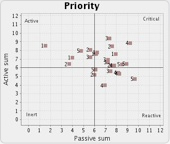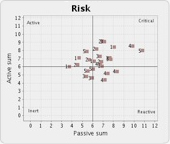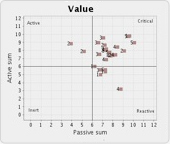ViewPoint Model in Concept
A brief introduction to the model and its purpose to assist in
previewing and stress-testing strategies and implementation plans - prior to investment.
VPM Concepts and Instrumentation inspired by...
Russell Ackoff 1919 - 2009, Pierre Wack 1922 - 1997 and Peter Senge 1947 -
VPM is about establishing where to unlearn, re-learn and where new learning has to be initiated.
The Viewpoint Model (VPM) is based on
systems thinking as well as
system dynamics and is deployed as a strategic scenario planning instrument.
The Institute for Strategy and Complexity Management is grounded in
systems thinking as the mental model to approach the scenario planning process.
System dynamics functions as the core for simulations and produces the projections from the ongoing changes in a scenario.
The VPM instrument was created in response to the void of information in strategic scenario planning about the decision maker’s mental models.
Pierre Wack: “Scenarios deal with two worlds;
the world of facts and the world of perceptions. They explore for facts but they aim at perceptions inside the heads of decision-makers. Their purpose is to gather and transform information of strategic significance into fresh perceptions."
"A valuable insight by Pierre Wack on his pioneering work at Royal Dutch Shell was that
scenarios had to connect with managers' assumptions, beliefs and concerns for the future in order to be of real use to them. In other words, scenario practice had to impact upon the mental models of decision-makers."
(Source HBR 1985, vol 63, no 5 Scenarios: Uncharted waters ahead).
The
Institute for Strategy and Complexity Management provided insights from more than a decade research on failed complex initiatives and projects. The
research outcome established that
plans fail within a pattern.Such patterns are ('the patterns identified by Nyiri's research result'):
Such patterns are ('the patterns identified by Nyiri's research result'):
1. Many plans fail not because of what was in the plan, but what was not in the plan.
2. The driving forces of failure are to be found in the realm of intangibles.
The reason for failed planning are primarily to find in lack of:
Learning
Communication
Commitment
Leadership
Scenario Planning
Viewpoint Modeling includes stakeholder dynamics, as from a systemic perspective, this dynamic is the most influential variable that determines future outcomes.
The viewpoint modeling method aims at finding the subliminal forces that were overlooked by the planners or could not be predicted by them. A VPM program starts with identifying the stakeholders and subsequently inviting them to join the VPM session(s).
Why are stakeholders so important? Because they will during the course of the transformation program/initiative play an influential role, be it constructive or stalling. Any plan based on a deterministic, technical, mechanistic roll out of events assumes that every party involved:
• is well informed,
• stays well informed
• is capable,
• is co-operative
• is constantly available
• has good intentions
• discusses in a constructive, open way
• refrains from interests other than the good of the project’s objective
• has unlimited capacities
•etcetera
Please note that such conditions occur rarely in the working world.
The Viewpoint Model aims to bring
deeper insight to the stakeholders about the impact on one another. From there
it invites to engage in critical reflection about the deployment of the correct systemic behaviors. Therefore, achieving a desired state of the strategy.
The Viewpoint Model taps on existing knowledge within and among the stakeholders, that’s why we call it ‘subliminal’, because in the
traditional planning procedure it remains ‘sub limen’, that is (Latin for): below the horizon of perception. The pleasant effect of this approach is that it hardly evokes resistance, as the contributions come from the participants themselves.
Consequently, the participants are eager to see what impact their self-estimated forces may have on the course of events. This creates a swift process of critical reflection on the effects of the driving forces. It also brings quickly a collective (shared) insight in the effects of the previously thought intangibles.
As a result it may start a constructive di
scussion about managing on the basis of systemic behavior.
Once this process has been initiated, the following move towards creating a credible strategy can be made.
The main areas of contribution by the Viewpoint Model in scenario planning is in social systems sciences and affect:
complexity reduction;
and stakeholder conflict resolution management
Making the complexity of the business environment visible is the key differentiator in the VPM planning method. Behavioral-based , so that the decision-making becomes not only more rational, but also better explainable.
With the help of simulations a clear picture and
impact-testing of the causal relationships between multiple strategy/project variables such as market growth, competition, internal projects, commitment, leadership, investment appetite etcetera can be built. This makes it easier to test the impact of certain factors. Once the simulation has been developed for projects, it can also be deployed at a higher level, namely of strategy definition. This allows for ‘back-testing’ to strategy level and gaining exposure to management’s transformation insights.
HOW DOES VPM DIFFERENTIATE FROM OTHER PLANNING MODELS AND INSTRUMENTS?
The acknowledgement of stakeholder dynamics in the models and simulations is key for planning projections. It is the ‘invisible gust of wind’, often absent in organizational planning. By extending the VPM to simulation by means of dynamic models, one can bring more objectivity and coherence in the stakeholder dynamics.
Stakeholder dynamics represents major driving forces that make or break implementation success.
OUTCOMES of VPM for a CHANGE and PLANNING PROGRAM:
Identified the relevant and irrelevant driving forces - that may lead to conflicts, when overlooked and not addressed properly
Assessed the initiative/project complexity levels - by highlighting the subliminal forces and assumptions
Measured the organizational readiness
Pre-viewed the corrective actions for a set of scenarios


